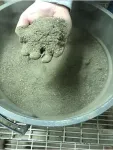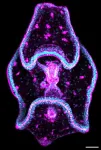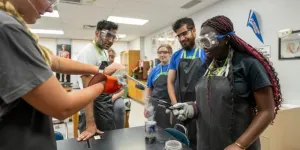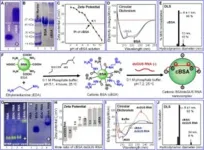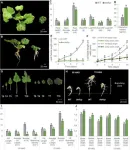(Press-News.org) UNIVERSITY PARK, Pa. — Feed costs for producing broiler chickens accounts for 60% to 70% of total production costs, and stump waste from the production of button mushrooms comprises nearly 30% of total mushroom weight. Marrying the two has the potential to reduce both cost and waste, especially in Pennsylvania, which is a national leader in the production of broiler chickens and button mushrooms.
To learn whether the two are compatible, a team of Penn State researchers conducted a new study to determine how supplementing the feed of broilers with mushroom stump waste affected the growth and health of the chickens.
In findings available online now, which will be published in the upcoming June issue of The Journal of Applied Poultry Research, the researchers reported that results from the 21-day trial indicate that broiler chickens fed up to 3% mushroom stump waste grew at the same rate as birds in the study that didn’t receive fungi supplementation, and their digestion was unaffected. Supplementation at 4% and 5%, the researchers found, slowed growth and interfered with the birds’ digestion of amino acids, or the organic compounds used to make proteins.
“The use of low-cost unconventional ingredients has become common practice when formulating poultry diets, and alternatives may include by-products that result from food crops used for human consumption,” said research team leader John Boney, Vernon E. Norris Faculty Fellow of Poultry Nutrition in the College of Agricultural Sciences. “Mushroom stump waste may include the potential added benefit of novel nutritional benefits for the broilers.”
The study included 480 broiler chickens purchased from a commercial hatchery on day of hatch. The birds were randomly selected, weighed, placed into groups and fed six dietary treatments. One control group received no fungi supplementation; others had diets with 1%, 2%, 3%, 4% and 5% percent mushroom stump waste. The researchers tested birds in the study for their ability to digest 17 amino acids and carefully tracked each one’s growth and health.
Mushroom stumps for the research were obtained from a commercial mushroom farm in southwest Pennsylvania and transported to Penn State. Mushroom stumps were dried in a small grain drier and ground into appropriate size particles for inclusion in poultry feed.
Pennsylvania is the foremost producer of mushrooms in the U.S., accounting for 64% of all button mushrooms produced in the country from 2021 to 2023, according to the U.S. Department of Agriculture’s National Agricultural Statistics Service. The three-year average of the Agaricus, or button, mushroom crop in the United States from 2021-23 was 321,601 metric tons. During harvest, the mushroom head is separated and used for human consumption, while the stump is composted as an agricultural by-product. On average, the stump waste is nearly 29% of the total mushroom weight, Boney noted.
“Therefore, roughly 93,264 metric tons of button mushroom stumps are composted yearly,” he said. “The stump is fibrous and contains therapeutic bioactive compounds with antimicrobial and antioxidant activities. Because of its nutritive and medicinal properties, mushroom stump waste may be a viable feedstuff generated from material previously deemed as waste. That’s particularly relevant in Pennsylvania, which ranks fourth in the U.S. in poultry production.”
Contributing to the research were Logan Erb, Courtney Poholsky and Alyssa Lyons, who all graduated with doctoral degrees in animal science from Penn State.
The American Mushroom Institute in Avondale funded this research.
END
Mushroom stump waste could be inexpensive, healthy chicken feed supplement
2024-06-07
ELSE PRESS RELEASES FROM THIS DATE:
Simply looking at the natural world in urban areas can reap benefits
2024-06-07
New eye-tracking research has shown that simply looking at natural elements during urban walks can offer significant mental health benefits.
The study, by Bangor University and Technion- Israel Institute of Technology, published in the scientific journal People and Nature, involved city-dwellers, and showed how paying visual attention to greenery, rather than human-made structures, can alleviate anxiety and enhance restorative feelings.
The 117 urban residents who took part in the study, were guided on a 45-minute urban walk, while wearing eye-tracking ...
Study adds new sea cucumber species to the research toolbox
2024-06-07
By Devon McPhee
WOODS HOLE, Mass. -- Scientists have a handful of standard research organisms, including fruit flies and mice, that they use to study the evolutionary development (evo-devo) of animal lineages over time. Yet the more research organisms they can study, the deeper our understanding of life and the more knowledge we have to advance biomedicine and ecological conservation.
Researchers at the Marine Biological Laboratory (MBL), Woods Hole, and the Stazione Zoologica Anton Dohrn (SZS) in Naples, Italy, have added to the evo-devo toolbox by establishing Holothuria tubulosa, ...
Advancing cancer tracking: DiFC detects rare cells noninvasively
2024-06-07
In the relentless fight against cancer, a new technology promises to shed light on how we track and understand the spread of this disease within the body. A research team from Northeastern University and Dartmouth College recently developed a remarkable tool called "diffuse in vivo flow cytometry" (DiFC), which allows for the noninvasive detection and counting of rare cancer cells circulating in the bloodstream.
Monitoring cancer spread in real time
In a recent publication in the Journal of Biomedical Optics (JBO), the research team detailed their innovative two-color DiFC system, capable of simultaneously detecting two distinct populations of cancer ...
nTIDE May 2024 Jobs Report: People with Disabilities Succeeding in Finding Jobs
2024-06-07
East Hanover, NJ – June 7, 2024 –May job numbers showed gains for people with disabilities, who continue to engage with the labor market at historic levels, according to today’s National Trends in Disability Employment – semi-monthly update (nTIDE), issued by Kessler Foundation and the University of New Hampshire’s Institute on Disability (UNH-IOD). Increases in both labor force participation and employment indicate that people with disabilities are not only striving to work but succeeding in finding jobs. ...
World's leading technology associations publish comprehensive curricular guidelines for computer science at the undergraduate level
2024-06-07
ACM, the Association for Computing Machinery, has joined with the IEEE Computer Society (IEEE-CS) and the Association for the Advancement of Artificial Intelligence (AAAI) to develop “Computer Science Curricula 2023” (CS2023). CS2023 provides a comprehensive guide outlining the knowledge and competencies students should attain for degrees in computer science and related disciplines at the undergraduate level.
Establishing uniform curricular guidelines for computer science disciplines is viewed as being essential to the ongoing vitality of the field and the future success of the students ...
Online professional education works for complex topics
2024-06-07
Online education is effective for teaching complicated topics like quantum information science (QIS) to high school science educators, according to a new paper by University of Texas at Arlington researchers published in The Physics Teacher.
“COVID-19 forced educators to adjust their educational best practices to an unfamiliar virtual classroom, and professional development was no different,” said Karen Jo Matsler, assistant professor in practice for UTeach at UTA and lead author on the study.
Ramon Lopez, professor of physics, was coprincipal investigator ...
Transforming agriculture: engineered nanoparticles for plant gene regulation
2024-06-07
In a major advancement for plant biology and agriculture, researchers have developed a novel method for systemic gene silencing in plants using engineered dsRNA-protein nanoparticles. This technique, which rapidly characterizes gene functions, could revolutionize in planta gene editing. The new approach addresses the longstanding challenge of transporting RNA molecules across plant cell membranes, providing a faster, non-transgenic solution for enhancing crop productivity.
Gene silencing in plants has faced significant challenges, primarily due to the difficulty of transporting RNA molecules across plant cell membranes and achieving systemic effects. Traditional genetic engineering ...
Understanding inequities in nurses’ moral distress during COVID-19
2024-06-07
Research has shown that, when nurses feel they are being prevented from taking a morally justifiable action or achieving an ethical outcome, it contributes to poor mental health, burnout, and intent to leave one’s job. Surveys from the COVID-19 pandemic found that a shortage of personal protective equipment (PPE) and lack of perceived support from hospital administrators were associated with higher levels of this moral distress.
University of Pennsylvania School of Nursing researchers and their collaborators hypothesized that nurses working in hospitals where Black patients predominantly access care—which they call Black-serving hospitals, or ...
Flavor unleashed: a scientific journey into the world of table grapes
2024-06-07
In a recent study, scientists have unlocked the secrets behind the diverse flavors of table grapes. By examining 38 different cultivars, the research offers unprecedented insights into the volatile compounds that shape our taste experiences, paving the way for enhanced grape quality and flavor.
The flavor of table grapes, influenced by various volatile compounds, plays a significant role in consumer preference and marketability. Traditional flavor analysis methods often fail to capture the complexity and diversity of grape flavors, especially in hybrid varieties. Conventional flavor classifications like muscat and foxy are insufficient for describing the wide range of flavors ...
Shrinking statures, growing insights: unraveling the genetic underpinnings of dwarfism in squash
2024-06-07
Unlocking the secrets of nature, a pioneering study has pinpointed a gene mutation with profound implications for plant height and stress tolerance. The discovery lies in the CpDWF5 gene, whose alteration leads to a compact squash plant with a unique resistance to salt stress, marking a leap forward in agricultural science.
In the quest to bolster crop yields and fortify plants against environmental stressors, the delicate interplay of phytohormones stands as a keystone. Yet, our grasp of these genetic levers, particularly those dictating plant stature and resilience to salinity, remains tenuous. Bridging ...
